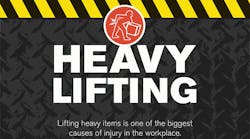Back injuries at work often are caused by lifting heavy or unstable loads. They also can be caused by poor posture and improper lifting technique. Victims of heavy lifting accidents can also sustain hernias and strain injuries, as well as damage to the hands, arms and upper body.
Employers have a duty to protect their employees. They are obliged to provide adequate training, equipment and guidance to prevent injury and harm. Despite these clearly defined obligations, heavy lifting accidents and manual handling accidents continue to happen.
As this infographic from Asons shows, the most common manual handling injury is to the back. Not only are back injuries generally painful, they can be disabling when your job involves heavy manual labor.
Back disorders can develop gradually as a result of microtrauma brought about by repetitive activity over time or can be the product of a single traumatic event. Because of the slow and progressive onset of this internal injury, the condition is often ignored until the symptoms become acute, often resulting in disabling injury.
According to OSHA, acute back injuries can be the immediate result of improper lifting techniques and/or lifting loads that are too heavy for the back to support. While the acute injury may seem to be caused by a single well-defined incident, the real cause is often a combined interaction of the observed stressor coupled with years of weakening of the musculoskeletal support mechanism by repetitive micro-trauma. Injuries can arise in muscle, ligament, vertebrae and discs.
Although back injuries account for no work-related deaths, they do account for a significant amount of human suffering, loss of productivity and economic burden on compensation systems. In both the United States and the UK, back disorders are one of the leading causes of disability for people in their working years and in the United States, afflict over 600,000 employees each year with a cost of about $50 billion annually, according to NIOSH. The frequency and economic impact of back injuries and disorders on the work force are expected to increase over the next several decades as the average age of the work force increases and medical costs go up.
To prevent such injuries, training that covers good lifting posture, the use of lifting equipment and guidance for managing heavy and awkward loads should be provided for employees.


